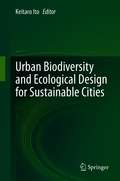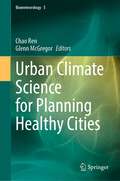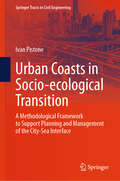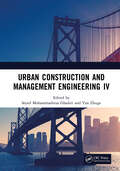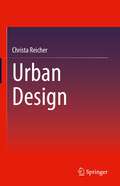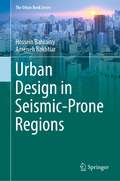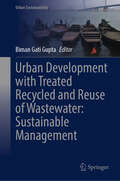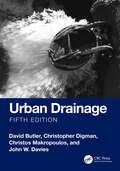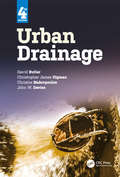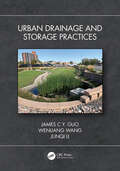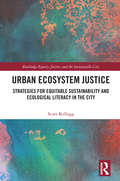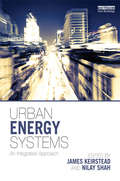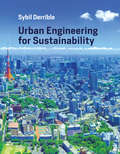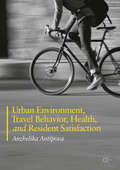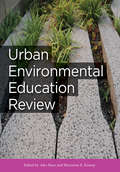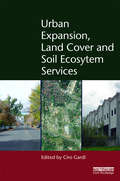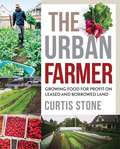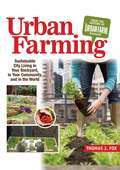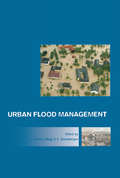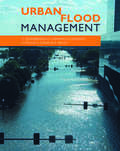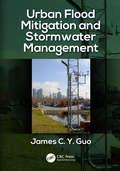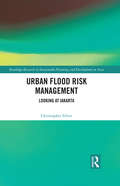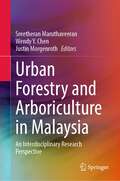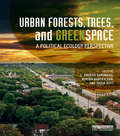- Table View
- List View
Urban Biodiversity and Ecological Design for Sustainable Cities
by Keitaro ItoThis book highlights various designs for urban green spaces and their functions. It provides an interesting meeting point between Asian, European and North America specialists (researchers, planners, landscape architects) studying urban biodiversity; urban biodiversity and green space; relations between people and biodiversity. The most important feature of this book is the unique point of view from each contributor towards “the relationship between nature and people in urban areas”, in the context of the ecosystem and biodiversity in urban areas and how to manage them. All chapters explore and consider the relationship between humans and nature in cities, a subject which is taking on increasing importance as new cities are conceptualized and planned. These discussion and examples would be useful for urban ecology researchers, biologists, city planners, government staff working in city planning, architects, landscape architects, and university instructors. This book can also be used as a textbook for undergraduate and postgraduate city planning, architecture or landscape architecture courses.
Urban Climate Science for Planning Healthy Cities (Biometeorology #5)
by Chao Ren Glenn McGregorThis volume demonstrates how urban climate science can provide valuable information for planning healthy cities. The book illustrates the idea of "Science in Time, Science in Place" by providing worldwide case-based urban climatic planning applications for a variety of regions and countries, utilizing relevant climatic-spatial planning experiences to address local climatic and environmental health issues. Comprised of three major sections entitled "The Rise of Mega-cities and the Concept of Climate Resilience and Healthy Living," "Urban Climate Science in Action," and "Future Challenges and the Way Forward," the book argues for the recognition of climate as a key element of healthy cities. Topics covered include: urban resilience in a climate context, climate responsive planning and urban climate interventions to achieve healthy cities, climate extremes, public health impact, urban climate-related health risk information, urban design and planning, and governance and management of sustainable urban development. The book will appeal to an international audience of practicing planners and designers, public health and built environment professionals, social scientists, researchers in epidemiology, climatology and biometeorology, and international to city scale policy makers.
Urban Coasts in Socio-ecological Transition: A Methodological Framework to Support Planning and Management of the City-Sea Interface (Springer Tracts in Civil Engineering)
by Ivan PistoneThis book delves into the concept of city-sea interface as a space of strong physical, ecological, social and functional connection between the edge of the city and the edge of the water, recalling the idea of an urban amphibious, in relation to its flexibility to community, environmental and management issue that prevent the sustainable development of urban coasts. In particular, the volume relates the spatial planning of littoral spaces with the demands of contemporary urban coastal society, since such complex places constitute crucial hubs for the fruition of coastal ecosystem services. The work explores these topics in the Euro-Mediterranean context, with regard to densely urbanised land-water areas through a methodological framework. A legal analysis describes the main coastal governance and Maritime Spatial Planning guidelines and how they are incorporated in national littoral management systems; the geo-spatial approach defines a spatial data model for the socio-environmental features of the interface; finally, the psycho-social approach aims at studying the social representations in relation to accessibility, uses and planning adaptation. This framework is proposed as a benchmarking tool: specifically, it has been applied to Marseille and Naples, two similar Mediterranean cities with complex city-sea interfaces. Moreover, it may also support the implementation of coastal-maritime planning at a local scale.
Urban Construction and Management Engineering IV
by Seyed Mohammadreza Ghadiri Zhuge YanUrban Construction and Management Engineering IV focuses on the research of construction technology and the engineering management in urban construction. This proceedings gathers the most cutting-edge research and achievements, and will provide scholars and engineers with preferable research directions and engineering solutions as reference. Subjects in this proceedings include: Civil Engineering Engineering Structure Engineering Management Low Carbon City Urban Management The works of this proceedings encourages development of civil engineering and construction technology. Thereby, the work promotes scientific information interchange between scholars from the top universities, research centers and high-tech enterprises working all around the world.
Urban Design
by Christa ReicherIn this basic textbook, prospective architects, urban and landscape planners receive assistance in working on urban development projects and designs. This edition has been expanded by two chapters on informal urban planning and regional urban development. The contents presented and their preparation are based on the design process in practice and embed it in a theoretical framework of necessary background knowledge. As an introduction, an overview of the understanding of the city, of urban structures and the laws governing them is given. In order to make the multi-layered structure of the city more comprehensible, it is broken down into different layers and building blocks. The approach to urban design is described using the "layer method" in the form of successive phases. Examples of urban development projects and competitions illustrate the individual design steps.
Urban Design in Seismic-Prone Regions (The Urban Book Series)
by Hossein Bahrainy Ameneh BakhtiarThis book presents practical guidelines and recommendations for the design in seismic-prone regions. It is based on extensive research and it includes original drawings and sketches at the macro and micro levels. It is the first time that an attempt has been made to publish a book on urban design in the seismic-prone regions, covering the needs of government officials, planners, economists, architects, engineers and scientists, with the purpose of planning for seismic risk reduction and the practical implementation of methodologies and findings in earthquake affected regions. The guidelines presented are expected to be immensely beneficial to all countries in the earthquake prone regions, particularly in the developing world.
Urban Development with Treated Recycled and Reuse of Wastewater: Sustainable Management (Urban Sustainability)
by Biman Gati GuptaThis book reviews all important aspects of wastewater treatment with the aim of shedding new light on these effects through a combined understanding of traditional and new paradigms. The book is divided into five sections, the first of which reinterprets wastewater types from the point of generation, examining the characteristics and different physicochemical properties of wastewater. The second section discusses recent advances in understanding process water from surface water to groundwater. A wide range of issues in an affected area polluted by heavy chemicals and metals used in different processes lead to different results, and the book then looks at the effects in different types of water, agricultural land, fruit and vegetables in the affected area. Public health in the area of interest is also greatly affected and the details are included here in this book. The final section gives us an overview of the process and ultimately inspires many to develop better technology of energy saving plants to minimise the damage of waste treatment and restore our ecosystem and health issues. This book will be of interest to all researchers in life sciences, biology, ecology, environmental engineering and many more, especially for sustainable urban development.
Urban Drainage
by David Butler Christopher Digman Christos Makropoulos John W. DaviesThis new edition of a well-established textbook covers the health, environmental, and engineering aspects of the management of rainwater and wastewater in areas of human development. Urban Drainage deals comprehensively not only with the design of new systems but also with the analysis and upgrading of existing infrastructure. Keeping its balance of principles, practice, and research, the fifth edition has had the most comprehensive update of any edition so far. It includes a new chapter on urban drainage planning, some significant restructuring of others and the introduction of new topics, including emerging contaminants, wastewater surveillance, AI, digital twins, and cyber-physical security. It also addresses current concerns about climate change impacts and intermittent wastewater pollution, and new ideas about sustainable and resilient systems. In all cases, the aim is to provide comprehensive, authoritative, and evidence-based content prioritising innovation, improved methods, and solutions.This is an essential text for undergraduates and graduate students, lecturers, and researchers in water engineering, environmental engineering, public health engineering, engineering hydrology, and related non-engineering disciplines. It also serves as a dependable and up-to-date reference for drainage engineers in water service providers, local authorities, and consulting engineers. Throughout the text, extensive examples are used to support and demonstrate the key issues.
Urban Drainage
by David Butler Christopher James Digman Christos Makropoulos John W. DaviesThis new edition of a well-established textbook covers the environmental and engineering aspects of the management of rainwater and wastewater in areas of human development. Urban Drainage deals comprehensively not only with the design of new systems, but also the analysis and upgrading of existing infrastructure. Keeping its balance of principles, practice and research, this new edition has significant new material on modelling, resilience, smart systems, and the global and local context. The two new authors bring further research and practice-based experience. This is an essential text for undergraduate and graduate students, lecturers and researchers in water engineering, environmental engineering, public health engineering, engineering hydrology, and related non-engineering disciplines. It also serves as a dependable reference for drainage engineers in water service providers, local authorities, and for consulting engineers. Extensive examples are used to support and demonstrate the key issues throughout the text.
Urban Drainage and Storage Practices
by James C.Y. Guo Wenliang Wang Junqi LiUrban Drainage and Storage Practices focuses on the latest developments in urban stormwater design methods using drainage and storage approaches for both water quality and quantity control. It covers both the conventional approaches to flood mitigation and low-impact methods for stormwater quality enhancement. Theory, practice, and modeling methods are presented to illustrate how to build a holistic stormwater drainage and storage system using urban open space and parks through multiple land use. Each chapter provides background theory, numerical experiments, illustrations, and Excel spreadsheets that outline design and calculation procedures. All urban watersheds are modeled as a series of cascading planes to drain stormwater from upstream roofs and parking lots onto downstream grass areas and vegetal beds. The drainage system is designed as a three-layer cascading system with various low-impact units for micro events, conveyance elements for minor events, and storage facilities for macro events. This book: presents the theory and practice of designing and building a stormwater system explains green approaches to designing and managing urban stormwater systems. This text is ideal for senior and graduate students studying urban hydrology, hydraulic engineering, and water resource management. It will also be useful for engineers requiring a technical book with hands-on practical examples.
Urban Ecosystem Justice: Strategies for Equitable Sustainability and Ecological Literacy in the City (Routledge Equity, Justice and the Sustainable City series)
by Scott KelloggMerging together the fields of urban ecology, environmental justice, and urban environmental education, Urban Ecosystem Justice promotes building fair, accessible, and mutually beneficial relationships between citizens and the soils, water, atmospheres, and biodiversity in their cities. This book provides a framework for re-centering issues of justice and fairness in sustainability discourse while challenging the profound ecological alienation experienced by urban residents. While the urban sustainability movement has had many successes in the past few decades, there remain areas for it to grow. For one, the benefits of sustainability have disproportionately benefited wealthier city residents, with concerns over equity, justice, and social sustainability frequently taking a back seat to economic and environmental considerations. Additionally, many city dwellers remain estranged from and unfamiliar with ecological processes, with urban environments often thought of as existing outside of nature or as hopelessly degraded. Through a citizen-centered lens, the book offers a guide to reconciling these issues by demonstrating how questions of equity, access, and justice apply to the biophysical dimensions of the urban ecosystem: soil, water, air, waste, and biodiversity. Drawing heavily from the fields of urban ecology, environmental justice, and ecological design, this book lays out a science of cities for people: a pedagogical platform that can be used to promote ecological literacy in underrepresented urban communities through affordable and decentralized means. This book provides both a theoretical and practical field guide to students and researchers of urban sustainability, city planners, architects, policymakers, and activists wishing to develop reciprocal relationships with urban ecologies.
Urban Energy Systems: An Integrated Approach
by James Keirstead Nilay ShahEnergy demands of cities need to be met more sustainably. This book analyses the technical and social systems that satisfy these needs and asks how methods can be put into practice to achieve this. Drawing on analytical tools and case studies developed at Imperial College London, the book presents state-of-the-art techniques for examining urban energy systems as integrated systems of technologies, resources, and people. Case studies include: a history of the evolution of London's urban energy system, from pre-history to present day a history of the growth of district heating and cogeneration in Copenhagen, one of the world's most energy efficient cities an analysis of changing energy consumption and environmental impacts in the Kenyan city of Nakuru over a thirty year period an application of uncertainty and sensitivity analysis techniques to show how Newcastle-upon-Tyne can reach its 2050 carbon emission targets designing an optimized low-carbon energy system for a new UK eco-town, showing how it would meet ever more stringent emissions targets. For students, researchers, planners, engineers, policymakers and all those looking to make a contribution to urban sustainability.
Urban Engineering for Sustainability (The\mit Press Ser.)
by Sybil DerribleA textbook that introduces integrated, sustainable design of urban infrastructures, drawing on civil engineering, environmental engineering, urban planning, electrical engineering, mechanical engineering, and computer science.This textbook introduces urban infrastructure from an engineering perspective, with an emphasis on sustainability. Bringing together both fundamental principles and practical knowledge from civil engineering, environmental engineering, urban planning, electrical engineering, mechanical engineering, and computer science, the book transcends disciplinary boundaries by viewing urban infrastructures as integrated networks. The text devotes a chapter to each of five engineering systems—electricity, water, transportation, buildings, and solid waste—covering such topics as fundamentals, demand, management, technology, and analytical models. Other chapters present a formal definition of sustainability; discuss population forecasting techniques; offer a history of urban planning, from the Neolithic era to Kevin Lynch and Jane Jacobs; define and discuss urban metabolism and infrastructure integration, reviewing system interdependencies; and describe approaches to urban design that draw on complexity theory, algorithmic models, and machine learning. Throughout, a hypothetical city state, Civitas, is used to explain and illustrate the concepts covered. Each chapter includes working examples and problem sets. An appendix offers tables, diagrams, and conversion factors. The book can be used in advanced undergraduate and graduate courses in civil engineering and as a reference for practitioners. It can also be helpful in preparation for the Fundamentals of Engineering (FE) and Principles and Practice of Engineering (PE) exams.
Urban Environment, Travel Behavior, Health, and Resident Satisfaction
by Anzhelika AntipovaThis book explores the intersections of urban development, travel patterns, and health. Currently, there is a lack of research concerning the subjective dimensions of accessibility in urban environments and travel behavior, as well as travel-related outcomes. Antipova fills this gap in the scholarship by developing an analysis of satisfaction and perception-related indicators at an intraurban level. Specifically, she investigates various aspects of urban environment from the perspective of resident perception and satisfaction, as well as the relationship between urban environment, travel behavior, activity patterns, and traveler health.
Urban Environmental Education Review (Cornell Series in Environmental Education)
Urban Environmental Education Review explores how environmental education can contribute to urban sustainability. Urban environmental education includes any practices that create learning opportunities to foster individual and community well-being and environmental quality in cities. It fosters novel educational approaches and helps debunk common assumptions that cities are ecologically barren and that city people don't care for, or need, urban nature or a healthy environment.Topics in Urban Environmental Education Review range from the urban context to theoretical underpinnings, educational settings, participants, and educational approaches in urban environmental education. Chapters integrate research and practice to help aspiring and practicing environmental educators, urban planners, and other environmental leaders achieve their goals in terms of education, youth and community development, and environmental quality in cities.The ten-essay series Urban EE Essays, excerpted from Urban Environmental Education Review, may be found here: naaee.org/eepro/resources/urban-ee-essays. These essays explore various perspectives on urban environmental education and may be reprinted/reproduced only with permission from Cornell University Press.
Urban Expansion, Land Cover and Soil Ecosystem Services (Routledge Studies in Urban Ecology)
by Ciro GardiMore than half of the world population now lives in cities, and urban expansion continues as rural people move to cities. This results in the loss of land for other purposes, particularly soil for agriculture and drainage. This book presents a review of current knowledge of the extension and projected expansion of urban areas at a global scale. Focusing on the impact of the process of 'land take' on soil resources and the ecosystem services that they provide, it describes approaches and methodologies for detecting and measuring urban areas, based mainly on remote sensing, together with a review of models and projected data on urban expansion. The most innovative aspect includes an analysis of the drivers and especially the impacts of soil sealing and land take on ecosystem services, including agriculture and food security, biodiversity, hydrology, climate and landscape. Case studies of cities from Europe, China and Latin America are included. The aim is not only to present and analyse this important environmental challenge, but also to propose and discuss solutions for the limitation, mitigation and compensation of this process.
The Urban Farmer
by Curtis Allen StoneThere are twenty million acres of lawns in North America. In their current form, these unproductive expanses of grass represent a significant financial and environmental cost. However, viewed through a different lens, they can also be seen as a tremendous source of opportunity. Access to land is a major barrier for many people who want to enter the agricultural sector, and urban and suburban yards have huge potential for would-be farmers wanting to become part of this growing movement.The Urban Farmer is a comprehensive, hands-on, practical manual to help you learn the techniques and business strategies you need to make a good living growing high-yield, high-value crops right in your own backyard (or someone else's). Major benefits include: Low capital investment and overhead costs Reduced need for expensive infrastructure Easy access to marketsGrowing food in the city means that fresh crops may travel only a few blocks from field to table, making this innovative approach the next logical step in the local food movement. Based on a scalable, easily reproduced business model, The Urban Farmer is your complete guide to minimizing risk and maximizing profit by using intensive production in small leased or borrowed spaces.Curtis Stone is the owner/operator of Green City Acres, a commercial urban farm growing vegetables for farmers markets, restaurants, and retail outlets. During his slower months, Curtis works as a public speaker, teacher, and consultant, sharing his story to inspire a new generation of farmers.
Urban Farming
by Thomas FoxIt doesn't take a farm to have the heart of a farmer. Now, due to a burgeoning sustainable-living movement, you don't have to own acreage to fulfill your dream of raising your own food. Hobby Farms Urban Farming, from Hobby Farm Press and the same people who bring you Hobby Farms and Hobby Farm Home magazine, will walk every city and suburban dweller down the path of self sustainability. Urban Farming will introduce readers to the concepts of gardening and farming from a high-rise apartment, participating in a community garden, vertical farming, and converting terraces and other small city spaces into fruitful, vegetableful real estate. This comprehensive volume will answer every up and coming urban farmer's questions about how, what, where and why-a new green book for the dedicated citizen seeking to reduce his carbon footprint and grocery bill.
Urban Flood Management: Introduction - 1st International Expert Meeting on Urban Flood Management
by Andras Szollosi-Nagy Chris ZevenbergenOver the last decades the world has witnessed a growing number of floods in urban areas. Climate change and rapid urbanization will exacerbate this trend. Flooding incidents in urbanized catchments and low-lying areas, such as polders, can lead to great public concern and anxiety, and their economical impact is severe. Apart from well-known flood prevention strategies, new approaches to the accommodation of floods are needed to create robust and sustainable solutions that enable us to cope with the ever-increasing urban pressure on flood-prone areas and the uncertainties created by climate change. Urban Flood Management comprises a multidisciplinary survey of recent developments in this field. Subjects like spatial and urban planning, flood insurance, flood resilience, flood proofing techniques, risk perception and preparedness and flood forecasting are treated by authorities from Brazil, India, the USA and Europe. Urban Flood Management will provide anyone active in the fields of water, risk and urban management with the latest information and insights that were obtained with a global and multidisciplinary approach.
Urban Flood Management
by Chris Zevenbergen Adrian Cashman Niki Evelpidou Erik Pasche Stephen Garvin Richard AshleyAlong with windstorms, floods are the most common and widespread of all natural disasters. Although they can often be predicted, they cause loss of life, damage and destruction, as many urban communities are located near coasts and rivers. In terms of victims, floods are responsible for more than half the deaths caused by natural catastrophes. As f
Urban Flood Mitigation and Stormwater Management
by James C GuoEffective urban drainage to manage stormwater and control flooding depends on good engineering, especially when an environmentally sustainable approach is being applied. This new text focuses on green methods and modelling techniques. It covers the principles of hydrology and drainage, low-impact-development (LID) designs, computer modelling techniques, the evaluation of existing systems, and planning for both new development and urban renewal. It outlines design procedures using examples, spreadsheet models, photos, and real-world design examples. Unlike other books, which focus on extreme events, this book covers hydrologic designs for both extreme and frequent events, and reflects the latest revolution in stormwater LID management, and takes a quantitative as well as a qualitative approach. PowerPoint® presentations and Excel® computer models are provided to follow and build on the exercises in the book. It is written especially for students on urban watershed courses, and also for those studying urban planning, landscaping, water resources, hydrology and hydraulics.
Urban Flood Risk Management: Looking at Jakarta (Routledge Research in Sustainable Planning and Development in Asia)
by Christopher SilverLike so many of the coastal cities in Southeast Asia (and other regions) established during European colonialism, there has been an ongoing challenge for decades dealing with the growing frequency and intensity of flooding. Jakarta’s flood problems since the 1990s have been nothing less than monumental and the inability of the local and national governments to mitigate flooding in Jakarta is the most visible manifestation of fundamental water management deficiencies. This book offers a comprehensive and systematic historical assessment of Jakarta’s water management practices from the colonial era through the early years of the Indonesian republic and Jakarta’s emergence as a sprawling megacity. This book draws upon a vast multidisciplinary literature and a wide array of government documents to unravel the complex history of water management that has led to approximately 40% of the city now lying below sea level. This book will be a useful reference to those who research on topics such as urbanization in Southeast Asia, sustainable development, urban and planning history, environmental planning, issues of water management (and flooding) and the politics of planning and development.
Urban Forestry and Arboriculture in Malaysia: An Interdisciplinary Research Perspective
by Sreetheran Maruthaveeran Wendy Y. Chen Justin MorgenrothThis book represents the latest research on urban forestry in a Malaysian context. It demonstrates that urban forestry is concerned not only with environmental enhancement, but also other aspects, such as recreation, health and well-being, and government policies. This edited collection provides a comprehensive overview of urban forestry studies from various researchers in Malaysia, and includes rich historical perspectives of urban forestry in the country. It also tackles related issues in policy. The greening of urban Malaysia in the 1970s focused primarily on beautification and was primarily the province of horticulturists, landscapers, nursery workers, town planners, and architects, with negligible inputs from foresters, particularly urban foresters. Perhaps for that reason, the term “landscaping” has been used more widely than “urban forestry” by government and private institutions, politicians, stakeholders, academicians, and the public. Nevertheless, the authors show that the concept of urban forestry is not new for developing countries such as Malaysia, where urbanization is increasing at a rapid rate. The book unpacks this demographic shift from a predominantly rural to a principally urban society. As the only unified body of work on urban forestry and arboricultural studies in Malaysia, this volume presents an important interdisciplinary reference for students, researchers, and scholars in physical geography, forestry and urban forestry, arboriculture and landscape architecture, both in Malaysia, and in other developing urbanizing countries, particularly in Southeast Asia. It is also an important resource for those working in environmental policy and practice, excavating the vital connection between the environment and well-being.
Urban Forests, Climate Change and Environmental Pollution: Physio-Biochemical and Molecular Perspectives to Enhance Urban Resilience
by Hukum SinghThis book contributes significantly to the international literature by bringing forth a novel and comprehensive exploration of urban resilience in the face of climate change and environmental pollution. Its focus on integrating physiological, biochemical, and molecular dimensions distinguishes it from existing literature. The book offers several key contributions, including an interdisciplinary approach to understanding the complex interactions within urban ecosystems. It includes cutting-edge insights that have not been extensively explored in existing literature, practical applications, and evidence-based strategies to enhance urban sustainability and resilience. The book has a global relevance to a diverse international readership and provides strategic guidance to policymakers and urban planners when making decisions to develop evidence-based strategies that cater to the specific challenges of cities. Urban forests play a critical role in enhancing the resilience of cities by providing numerous benefits, including improved air quality, reduced urban heat island effect, and enhanced biodiversity, ultimately improving urban health. Besides, urban forests are a crucial natural-based solution (NbS) to mitigate air pollution and climate change impacts in cities. However, in the face of climate change and environmental pressures, urban forests face significant challenges to their survival and functionality. This book explores the complex morpho-physio-biochemical and molecular changes that enable urban forests to flourish amidst climate change and environmental pollution. It examines how urban trees modulate their morphological structures, including root systems and physiological and biochemical functioning, and molecular alterations to withstand changing urban climatic and environmental conditions.
Urban Forests, Trees, and Greenspace: A Political Ecology Perspective (Routledge Studies in Urban Ecology)
by L. Anders Sandberg Adrina Bardekjian Sadia ButtUrban forests, trees and greenspace are critical in contemporary planning and development of the city. Their study is not only a question of the growth and conservation of green spaces, but also has social, cultural and psychological dimensions. This book brings a perspective of political ecology to the complexities of urban trees and forests through three themes: human agency in urban forests and greenspace; arboreal and greenspace agency in the urban landscape; and actions and interventions in the urban forest. Contributors include leading authorities from North America and Europe from a range of disciplines, including forestry, ecology, geography, landscape design, municipal planning, environmental policy and environmental history.
